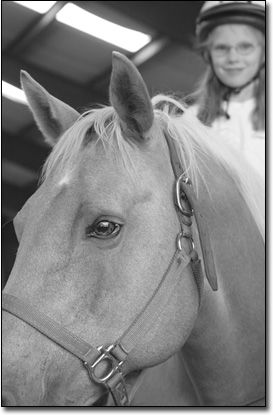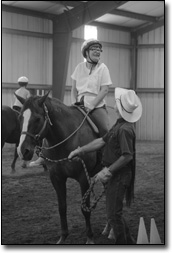 |
| Kelly Henderson, 10, begins her
ride with the Cadence Therapeutic Riding Center.
The lesson,
in which she follows directions in sequence, is
designed to help build her auditory memory
skills./Photo by Todd Newcomer. |
I t is a dance of sorts, as the pairs gracefully move in concentric
circles and then trot in serpentines and figure eights around orange
cones. The actions are marked by the rhythm of hooves pounding a dirt
arena and thunderclouds chanting in the distance.
Richard, a three-year Cadence Therapeutic Riding veteran, rests horizontally
on the aged spine of his 19-year-old palomino quarter horse, Alley.
Their bond forms around Alley's past dance experience as a show horse
and Richard's acute mind and sensory skills, despite having cerebral
palsy. These sensory skills seem to psychically guide his equine partner's
footwork.
Riders with disabilities and horses dance in teams of four or five.
Cadence Therapeutic Riding aides act solely to lead, adjust and align
the motion and not interfere with the cadence of the horse-rider union.
Three different groups come together for an hour every week during a
process that will span eight weeks. Program Director Timmie Sohramm
says that approximately 15 disabled riders participate each session,
whose lessons are often provided through scholarships.
Cadence received a five-year re-accreditation in 2000 from The North
American Riding for the Handicapped Association (NARHA). Since its beginning
in 1995, more than 200 clients have participated in Cadence programs,
which include therapeutic riding lessons for people with disabilities
and grief-relief programs. Sohramm originally worked with a therapeutic
riding program in Phoenix and didn't believe that Durango had the resources
to support such a program.
"Durango is so great in that way," says volunteer Patti Dedrick. "Durango
offers great programs like Cadence and Adaptive Sports."
 |
| Volunteers Jim Addington, left,
and Frank Cianci take a load off in between sessions
at the Frazier Ranch
horse arena, where Cadence holds its programs./Photo
by Todd Newcomer |
The riders, who range in age, meet in a covered arena at Frazier Ranch,
north of Durango, where a group of six horses and colored throwing rings
and obstacles await them. Cadence offers the rider the opportunity to
transcend the constraints of wheelchairs, crutches and the label of
disability. According to Dedrick, the program gives riders a different
vantage point and increases confidence.
"There are so many benefits for the rider, both the physical and for
oiling the spirit and mind," says Dedrick. "It's important for Richard's
physicality to get his body moving and also for a sense of social interaction,
so he can feel that he's actually a part of the world."
Research shows that therapeutic riding can have emotional, mental and
physical rewards. For individuals like Richard with impaired mobility,
riding gently moves their bodies in a fashion similar to walking; they
can benefit with increased strength, mobility, muscle control and balance.
Riders with mental or cognitive disabilities find motivation through
patience, communication and concentration. If a rider is psychologically
or emotionally pained, the horse can provide a great medium for an interpersonal
relationship, which can foster self-esteem.
Dedrick explains that despite being born with cerebral palsy, riders
like Richard have highly keen mental skills, which are often overlooked.
 |
Savannah Gilliam beams with
excitement as Jim Addington, a volunteer
of 15 years, holds onto her
horse./Photo by Todd Newcomer. |
"Cerebral palsy affects their motor and physical skills, but their
minds remain very acute," says Dedrick. "It took me years to understand
that they're just as sharp as the rest of us. It must get so frustrating
to constantly get passed over."
By practicing the commands "whoa" and "walk-on" along with his balance,
posture and control, Richard can effectively communicate with Alley
and keep his mental skills sharp.
Cadence recently made the move from being a pleasure-riding program
to a horsemanship program. Sohramm says that the change has 4 been instrumental
in proving valuable knowledge and hands-on experience.
"The weekly lessons and homework differ each week," says Sohramm. Some
examples include safety and riding skills; horse physiology, anatomy,
and psychology; and the uses of horses and their history.
However, the riders and their comfort level around the horses most
accurately measure the success of the program, according to Sohramm.
"Some riders start out thinking that the scariest part is getting on
and off the horse, but eventually they want more challenges," he says. "They
ask to do the same things they see Frazier Ranch horse owners doing,
and eventually ask to ride off lead."
And the bond that forms between the members of the riding team - rider,
horse and volunteer - may speak best to the success of Cadence Therapeutic
Riding.
"You get back 100 percent more than you put into this," says Dedrick.
The hour ends, feet go back on the ground, bodies return to wheelchairs,
and farewells are exchanged. Richard shouts to Dedrick and other volunteers
as they leave the arena, "I love you."
"I love you too," echoes a volunteer's voice. "He makes my week ...
that guy."
Cadence Therapeutic Riding sessions run through Aug. 11 and volunteers
are needed. For more information, call 749-RIDE (7433).
|